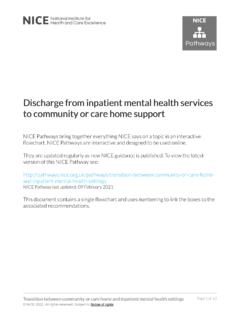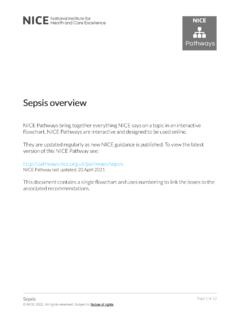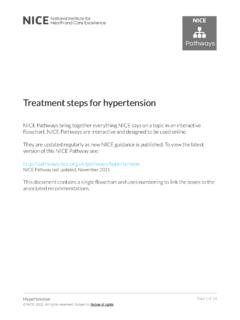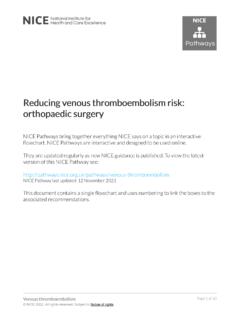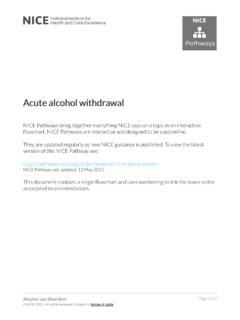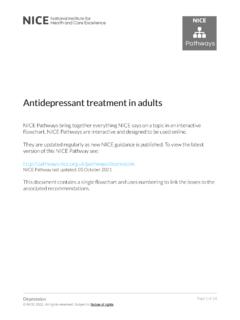Transcription of Care in third stage of labour
1 Care in third stage of labour NICE Pathways bring together everything NICE says on a topic in an interactive flowchart. NICE Pathways are interactive and designed to be used online. They are updated regularly as new NICE guidance is published. To view the latest version of this NICE Pathway see: NICE Pathway last updated: 09 December 2021. This document contains a single flowchart and uses numbering to link the boxes to the associated recommendations. Intr Intrapartum apartum care Page 1 of 10. NICE 2022. All rights reserved. Subject to Notice of rights. Care in third stage of labour NICE Pathways Intr Intrapartum apartum care Page 2 of 10. NICE 2022. All rights reserved. Subject to Notice of rights. Care in third stage of labour NICE Pathways 1 Woman in third stage of labour For the purposes of this guidance, use the following definition: The third stage of labour is the time from the birth of the baby to the expulsion of the placenta and membranes. 2 General principles of care Recognise that the time immediately after the birth is when the woman and her birth companion(s) are meeting and getting to know their baby.
2 Ensure that any care or interventions are sensitive to this and minimise separation or disruption of the mother and baby. 3 Observations Record the following observations for a woman in the third stage of labour : her general physical condition, as shown by her colour, respiration and her own report of how she feels vaginal blood loss. 4 Active and physiological management Active management of the third stage involves a package of care comprising the following components: routine use of uterotonic drugs deferred clamping and cutting of the cord controlled cord traction after signs of separation of the placenta. Physiological management of the third stage involves a package of care that includes the following components: no routine use of uterotonic drugs no clamping of the cord until pulsation has stopped delivery of the placenta by maternal effort. Intr Intrapartum apartum care Page 3 of 10. NICE 2022. All rights reserved. Subject to Notice of rights. Care in third stage of labour NICE Pathways Explain to the woman that active management : shortens the third stage compared with physiological management is associated with nausea and vomiting in about 100 in 1000 women is associated with an approximate risk of 13 in 1000 of a haemorrhage of more than 1 litre is associated with an approximate risk of 14 in 1000 of a blood transfusion.
3 Explain to the woman that physiological management : is associated with nausea and vomiting in about 50 in 1000 women is associated with an approximate risk of 29 in 1000 of a haemorrhage of more than 1 litre is associated with an approximate risk of 40 in 1000 of a blood transfusion. Advise the woman to have active management of the third stage , because it is associated with a lower risk of a postpartum haemorrhage and/or blood transfusion. If a woman at low risk of postpartum haemorrhage requests physiological management of the third stage , support her in her choice. Document in the records the decision that is agreed with the woman about management of the third stage . For active management , administer 10 IU of oxytocin by intramuscular injection with the birth of the anterior shoulder or immediately after the birth of the baby and before the cord is clamped and cut. Use oxytocin as it is associated with fewer side effects than oxytocin plus ergometrine. After administering oxytocin , clamp and cut the cord: Do not clamp the cord earlier than 1 minute from the birth of the baby unless there is concern about the integrity of the cord or the baby has a heart rate below 60 beats/minute that is not getting faster.
4 Clamp the cord before 5 minutes in order to perform controlled cord traction as part of active management . If the woman requests that the cord is clamped and cut later than 5 minutes, support her in her choice. After cutting the cord, use controlled cord traction. Perform controlled cord traction as part of active management only after administration of oxytocin and signs of separation of the placenta. Intr Intrapartum apartum care Page 4 of 10. NICE 2022. All rights reserved. Subject to Notice of rights. Care in third stage of labour NICE Pathways Record the timing of cord clamping in both active and physiological management . Advise a change from physiological management to active management if either of the following occur: haemorrhage the placenta is not delivered within 1 hour of the birth of the baby. Offer a change from physiological management to active management if the woman wants to shorten the third stage . Do not use either umbilical oxytocin infusion or prostaglandin routinely in the third stage of labour .
5 Quality standards The following quality statement is relevant to this part of the interactive flowchart. 6. Delayed cord clamping 5 Prolonged third stage and complications Prolonged third stage Diagnose a prolonged third stage of labour if it is not completed within 30 minutes of the birth with active management or within 60 minutes of the birth with physiological management . Follow the recommendations on managing a retained placenta [See page 7]. Complications If there is postpartum haemorrhage, a retained placenta or maternal collapse, or any other concerns about the woman's wellbeing: transfer her to obstetric-led care (following the general principles for transfer of care). carry out frequent observations to assess whether resuscitation is needed. Intr Intrapartum apartum care Page 5 of 10. NICE 2022. All rights reserved. Subject to Notice of rights. Care in third stage of labour NICE Pathways 6 Postpartum haemorrhage Immediate management If a woman has a postpartum haemorrhage: call for help give immediate clinical treatment: emptying of the bladder and uterine massage and uterotonic drugs and intravenous fluids and controlled cord traction if the placenta has not yet been delivered continuously assess blood loss and the woman's condition, and identify the source of the bleeding give supplementary oxygen arrange for transfer of the woman to obstetric-led care (following the general principles for transfer of care).
6 Allocate a member of the healthcare team to stay with the woman and her birth companion(s), explain what is happening, answer any questions and offer support throughout the emergency situation. First-line treatment Administer a bolus of one of the following as first-line treatment for postpartum haemorrhage: oxytocin (10 IU intravenous) or ergometrine ( mg intramuscular) or combined oxytocin and ergometrine (5 mg intramuscular). Second-line and further treatment Offer second-line treatment for postpartum haemorrhage if needed. No particular uterotonic drug can be recommended over any other; options include: repeat bolus of: oxytocin (intravenous). Intr Intrapartum apartum care Page 6 of 10. NICE 2022. All rights reserved. Subject to Notice of rights. Care in third stage of labour NICE Pathways ergometrine (intramuscular, or cautiously intravenously). combined oxytocin and ergometrine (intramuscular). misoprostol oxytocin infusion carboprost (intramuscular). Assess the need for adjuvant options for managing significant continuing postpartum haemorrhage, including: tranexamic acid (intravenous).
7 Rarely, in the presence of otherwise normal clotting factors, rFactor VIIa, in consultation with a haematologist. If the haemorrhage continues: perform examination under anaesthetic ensure that the uterus is empty and repair any trauma consider balloon tamponade before surgical options. Be aware that no particular surgical procedure can be recommended over any other for treating postpartum haemorrhage. See the NICE Pathway on blood transfusion. Detecting, managing and monitoring haemostasis NICE has published diagnostics guidance on detecting, managing and monitoring haemostasis: viscoelastometric point-of-care testing (ROTEM, TEG and Sonoclot systems). 7 Retained placenta Secure intravenous access if the placenta is retained, and explain to the woman why this is needed. Do not use umbilical vein agents if the placenta is retained. Do not use intravenous oxytocic agents routinely to deliver a retained placenta. Give intravenous oxytocic agents if the placenta is retained and the woman is bleeding Intr Intrapartum apartum care Page 7 of 10.
8 NICE 2022. All rights reserved. Subject to Notice of rights. Care in third stage of labour NICE Pathways excessively. If the placenta is retained and there is concern about the woman's condition: offer a vaginal examination to assess the need to undertake manual removal of the placenta explain that this assessment can be painful and advise her to have analgesia. If the woman reports inadequate analgesia during the assessment, stop the examination and address this immediately. If uterine exploration is necessary and the woman is not already in an obstetric unit, arrange urgent transfer (following the general principles for transfer of care). Do not carry out uterine exploration or manual removal of the placenta without an anaesthetic. 8 Care of the woman and newborn baby See Intrapartum care / Care of the woman and newborn baby Intr Intrapartum apartum care Page 8 of 10. NICE 2022. All rights reserved. Subject to Notice of rights. Care in third stage of labour NICE Pathways Sources Intrapartum care for healthy women and babies (2014 updated 2017) NICE guideline CG190.
9 Detecting, managing and monitoring haemostasis: viscoelastometric point-of-care testing (ROTEM, TEG and Sonoclot systems) (2014) NICE diagnostics guidance 13. Your responsibility Guidelines The recommendations in this guideline represent the view of NICE, arrived at after careful consideration of the evidence available. When exercising their judgement, professionals and practitioners are expected to take this guideline fully into account, alongside the individual needs, preferences and values of their patients or the people using their service. It is not mandatory to apply the recommendations, and the guideline does not override the responsibility to make decisions appropriate to the circumstances of the individual, in consultation with them and their families and carers or guardian. Local commissioners and providers of healthcare have a responsibility to enable the guideline to be applied when individual professionals and people using services wish to use it.
10 They should do so in the context of local and national priorities for funding and developing services, and in light of their duties to have due regard to the need to eliminate unlawful discrimination, to advance equality of opportunity and to reduce health inequalities. Nothing in this guideline should be interpreted in a way that would be inconsistent with complying with those duties. Commissioners and providers have a responsibility to promote an environmentally sustainable health and care system and should assess and reduce the environmental impact of implementing NICE recommendations wherever possible. Technology appraisals The recommendations in this interactive flowchart represent the view of NICE, arrived at after careful consideration of the evidence available. When exercising their judgement, health professionals are expected to take these recommendations fully into account, alongside the Intr Intrapartum apartum care Page 9 of 10. NICE 2022. All rights reserved.


